BBC Earth newsletter
BBC Earth delivered direct to your inbox
Sign up to receive news, updates and exclusives from BBC Earth and related content from BBC Studios by email.
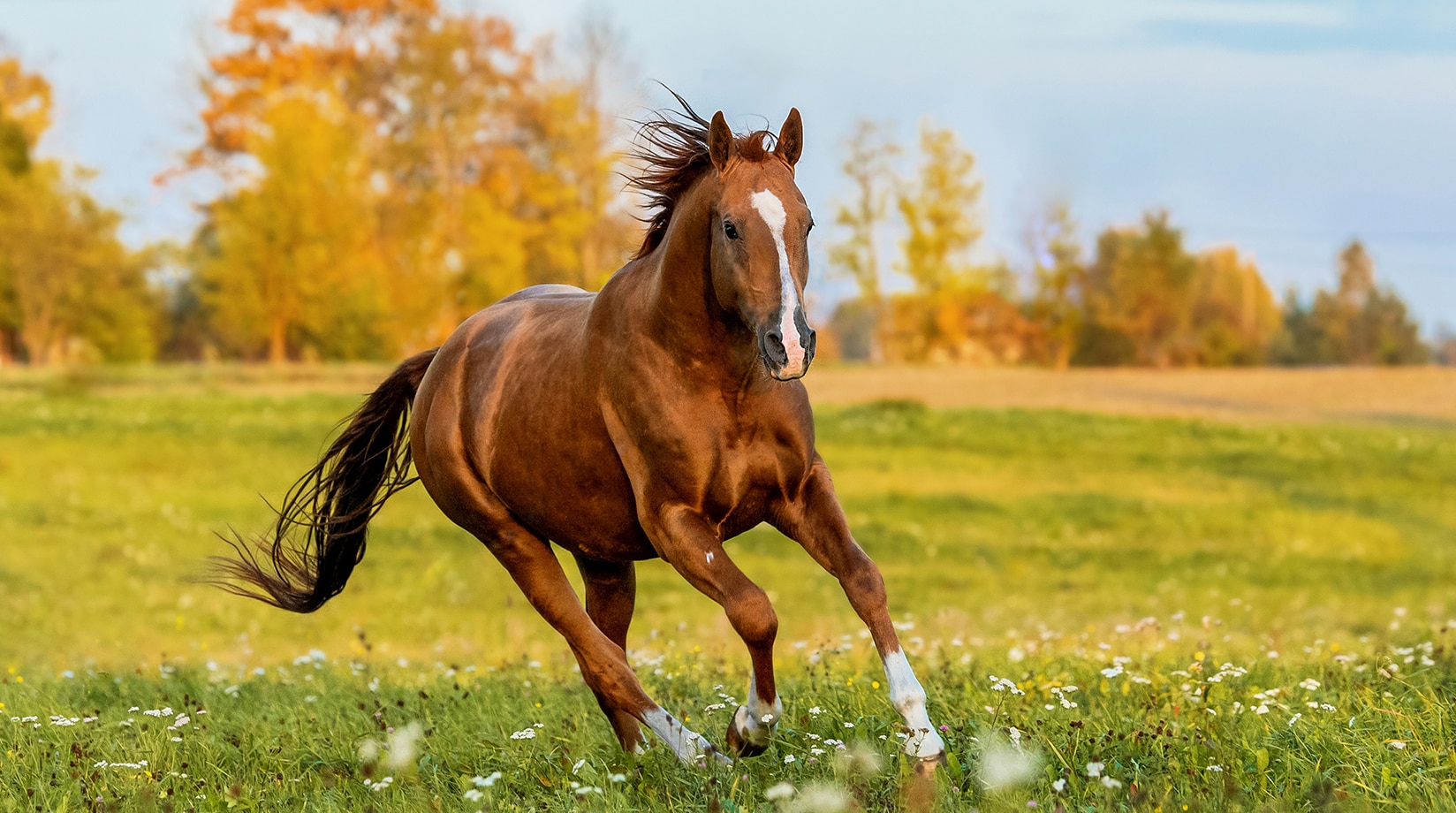
The horse is a four-legged herd animal. Various breeds of the animal have been domesticated and are used for work, riding and as a source of food and milk. Historically, the domestication of horses helped humans to spread across the world and also improved their ability to farm.
Domesticated horses (Equus ferus caballus) come in a host of different shapes, colours and sizes. From tiny Shetland ponies, who stand as high as your waist, to giant Shire horses that tower over us, humans have bred horses over the centuries to fulfil a variety of purposes.
Horses have a long mane that runs down their neck in a thin stripe, and a long flowing tail. Their coats are typically white, grey, brown, black, or a combination of these.
As a prey animal for mountain lions, wolves and bears, horses have evolved to possess excellent hearing and near-360 degree vision. This is typical for a species which must watch out for predators. But horses have less impressive grey matter. The average horse’s brain typically weighs around 600g – about half that of a human’s brain.
Being as fast and as strong as a horse requires some hefty organs. Horses have big hearts, which can weigh several kilogrammes and grow as large as a melon. Hearts this large help horses to pump more blood around their bodies so that they can deliver oxygen to their large, powerful muscles, which are needed for sprinting long distances. Horses are incredibly lean animals – half of their body weight is made up of muscle.
Horses can live into their 40s, though the average lifespan is typically around 25-30 years.
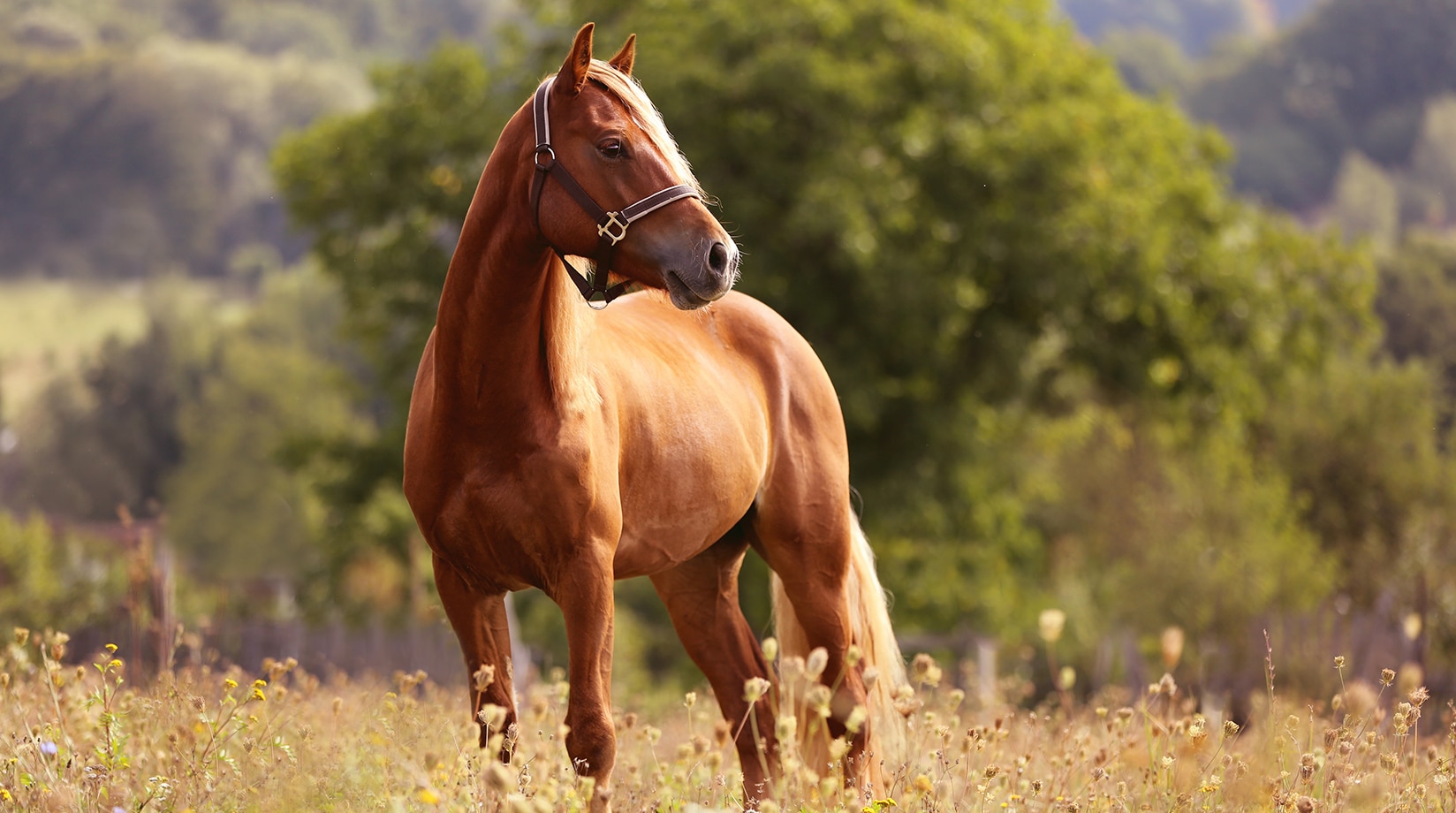
The largest breed of horse is the Shire, closely followed by the Clydesdale, Belgian Draft, Percheron and Suffolk Punch.1 These breeds can weigh over 900kg and typically measure 160-210cm (5.2-6.9ft) from the ground to the top of their shoulders, known as a horse’s "withers”. Traditionally, domesticated horses have been measured in "hands", with one hand measuring slightly over 10cm. They are still measured this way by horse breeders.
All five breeds belong to a group of horses called draft horses. These breeds are known for their incredible strength and stamina and were used to pull ploughs and other farm machinery before the advent of motorised tractors. They were also used in wars to move large artillery.
You might have heard of the term "horsepower". This term originated in the 18th Century as a way to measure the power output of steam engines by comparing it to working horses. Interestingly, while the term implies the power of a single horse, the strongest horses can actually produce a peak power output that exceeds 15 horsepower! Today, this term is still widely used to denote a car's power.
These breeds are rarely used for farming today and are bred for show instead. The Suffolk Punch is one of the rarest breeds of horse and numbers fewer than 1,000 individuals worldwide.2
The smallest horse breeds are miniature horses, including Falabellas, Shetlands, Nomas and Yonagunis. These breeds are exclusively bred for show and for keeping as pets.
The Quarter horse and Thoroughbred are two of the fastest breeds of horse. The former can reach top speeds in excess of 50mph (80kmph).3
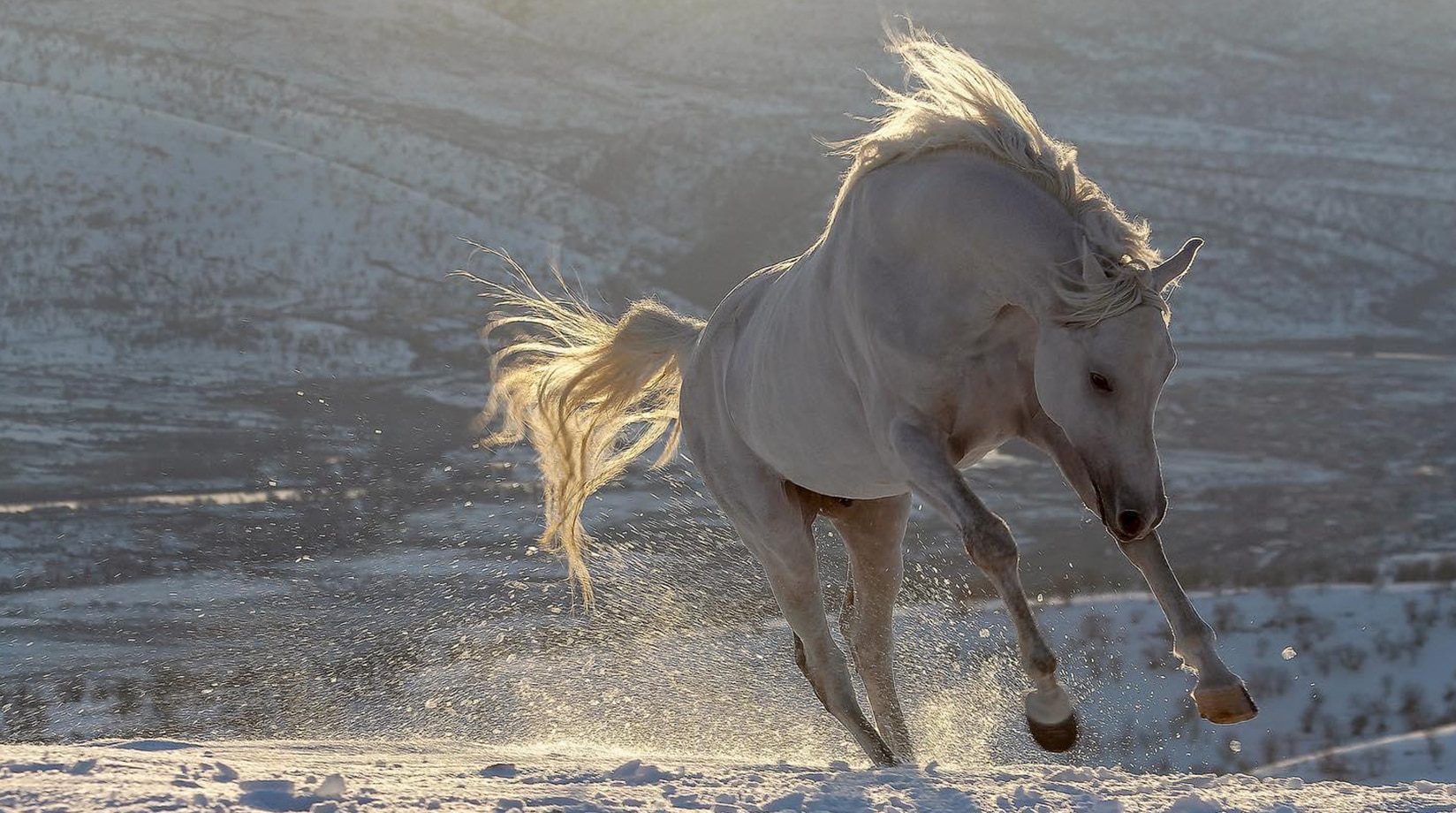
Young horses are called a foal for their first year after birth. Then from one year until adulthood they are either a filly if they are female or colt if they are male. Historically, in the wild, herds of horses would have consisted of separate groups of males and females. The males would track the female groups and attempt to win the right to mate with the group of females exclusively. Males might fight with each other by kicking with their forelegs and biting each other.
During mating, the successful male, called a stallion, might bite the neck of the female to assert dominance, while unsuccessful males return to their group of bachelors.
Horses have long pregnancies – generally around 11 months, which is longer than human pregnancies. Newborn horses, called foals, can walk and run within hours of being born, which was essential to their survival in the wild as they kept up with the rest of their herd.
Until the early 20th century, wild horses lived in huge, open areas of grassland in Central Asia called the Eurasian steppe. This habitat stretches from Eastern Europe to the east of China south of Siberia and north of the Gobi desert. The Eurasian Steppe is temperate and semi-arid, meaning it is quite dry, not too hot or cold and offers a climate which horses find comfortable to live in.
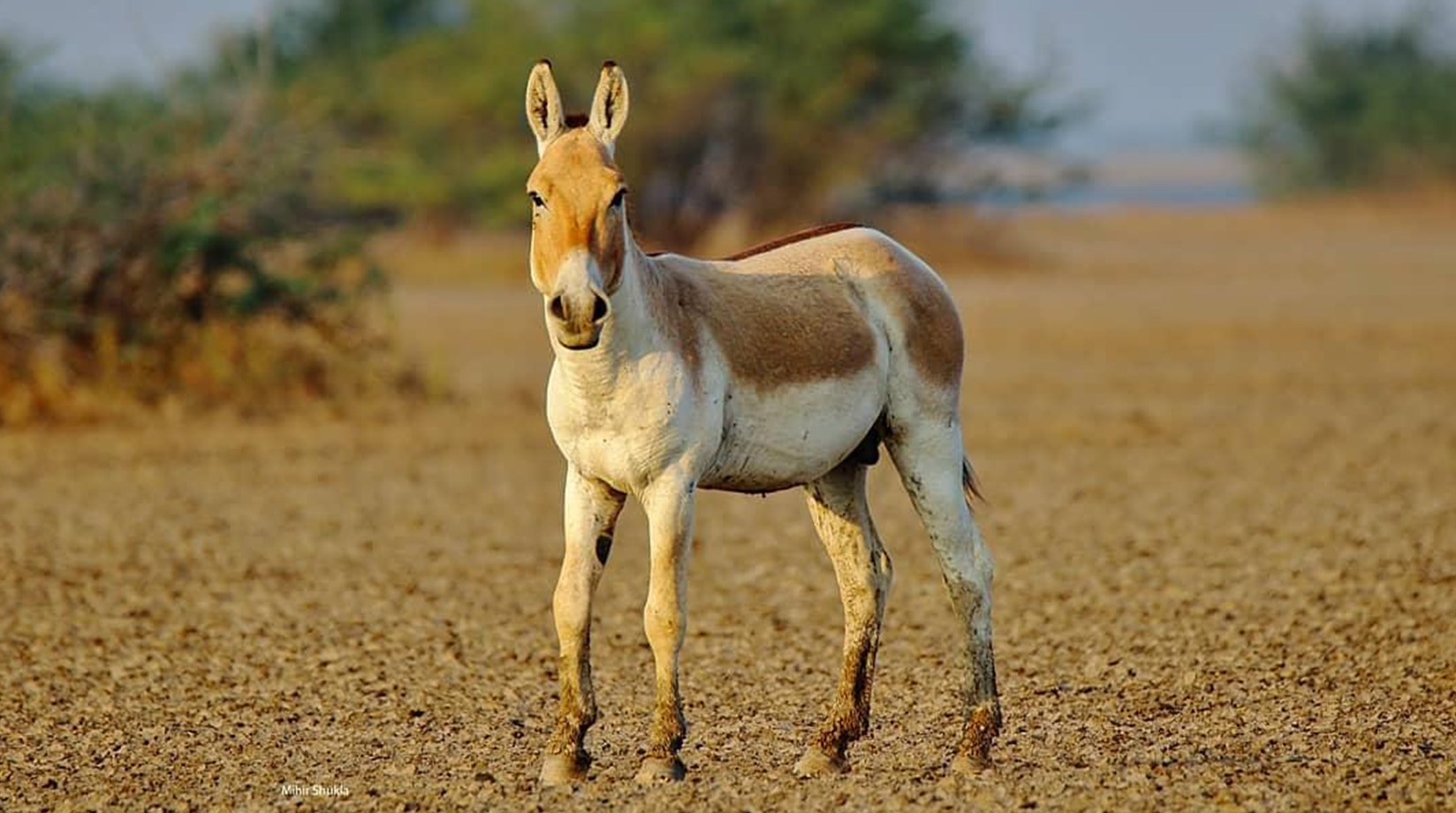
The only close living relative of the domesticated horse is a species called Przewalski's horse (Equus ferus przewalskii), the last remaining species of wild horse. Przewalski's horses, named after the Russian-Polish explorer Nikolay Przhevalsky, are not ancestors of today’s domesticated horses, they are in fact distant cousins who have been reintroduced into the wild in some areas of Mongolia.4
Przewalski's horses once lived across the steppes of Russia, Mongolia, China and Kazakhstan, but were hunted to extinction in the wild in the 20th century.
Historically, wild horses were revered by humans, due to both their rarity and the difficulty in catching them. This is mentioned in ancient texts written by the Tibetan monk Bodowa in 900 AD and in accounts of the Mongol ruler Genghis Khan’s travels in the 1200s.
Western animal collectors and zoos attempted to catch these wild horses for their collections. But because Przewalski's horses are shy and very fast, the collectors and zoos had to resort to killing the adults and capturing the foals. Many foals died in captivity or in transit to the zoos. Others were killed by trophy hunters.
The last wild Przewalski's horse was seen in Mongolia in 1969. But they were reintroduced to protected areas in Mongolia after being bred from captive populations in 1994. These herds are considered fully wild and live without any assistance from humans. There are now some populations in Chinese nature reserves, such as Kalamaili Nature Reserve and the Dunhuang Xihu National Nature Reserve, which are human-fed in the winter. In total, there are approximately 387 reintroduced Przewalski's horses in Mongolia and they are considered endangered on the IUCN Red List.5
All of the Przewalski's horses alive today, both captive and reintroduced, are descended from 12 wild-caught horses which were bred with domesticated horses. This has led to concerns about the potential for inbreeding and the outlook for the species in the long term. To address this, there is international cooperation between different captive breeding programmes so that genetic diversity can be maintained, and wild populations are closely monitored for disease.
It is thought that humans once lived alongside Przewalski's horses in Europe. The horses appear to feature in cave paintings dating as far back as 20,000 years ago in Spain, Italy and France – although these paintings might depict an extinct horse species called Equus ferus gmelini, but some zoologists question whether this is a separate species in its own right.
While very similar to domesticated horses, Przewalski's horses are slightly different — for instance, their manes stand up on the back of their neck like a bristly brush. This looks a little like a donkey’s mane, rather than a horse’s flowing locks. Przewalski's horses have little by way of forelocks — the fringe on the front of the mane which falls between the ears and over the face of a domesticated horse — which again presents a greater similarity with asses and donkeys than with domesticated horses.
Other "wild" horses are actually feral domesticated horses. For example, a Polish domesticated horse breed called the Konik has become feral in some areas of Europe, and has even been introduced intentionally to some nature reserves to control plant species.6 The Konik ponies in Wicken Fen in Cambridgeshire and Redgrave Fen in Suffolk, UK, help to manage wetlands by preventing some larger species of plants from dominating the landscape.
Domestic horses become feral when they either escape or are released into a wild landscape and lose their tameness. These horses might become more dangerous to humans who approach them.
Aside from Przewalski's horses, the Equus genus also features the plains zebra, Grevy’s zebra, Kiang (an ass-like animal) and wild asses, from which domesticated asses and donkeys were originally bred.
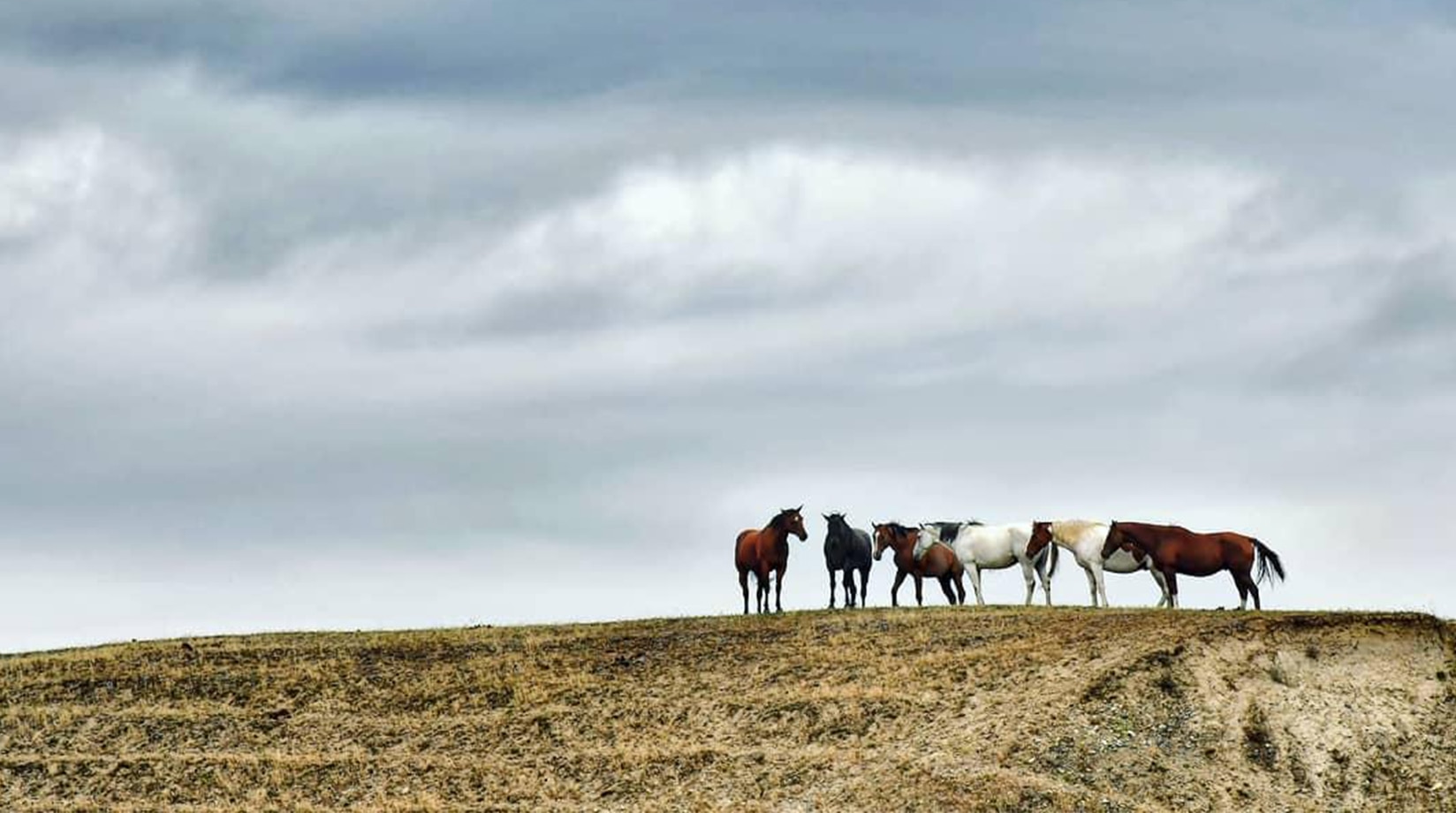
It is believed that humans first domesticated horses in around 3500 BC in Central Asia. This is largely due to the discovery of archaeological evidence including bridles – the straps held around the head of horses from which a rein is attached – and corrals, or temporary enclosures, from this time at a settlement called Botai in modern-day Kazakhstan.7
To what degree these horses were domesticated is contentious. Some archaologists exploring sites in Asia have suggested that they were kept in fenced corrals to provide a source of easily-available food and milk, but were largely left to their own devices. Some modern human societies, like the Sami people from the north of Finland and Norway, keep reindeer in a similar fashion. Whether they were intentionally bred and trained for riding is much harder to prove.
However, it is possible that humans have been riding horses since around 3000 BC, which would coincide with the massive increase in the spread of nomadic Central Asian cultures like the Yamnaya and the invention of heavy, solid-wheeled wagons around that time.
However, genetic evidence suggests that modern horses – Equus ferus caballus – are descended from another population of animals from around 2000 BC, which replaced the first domesticated horses.8
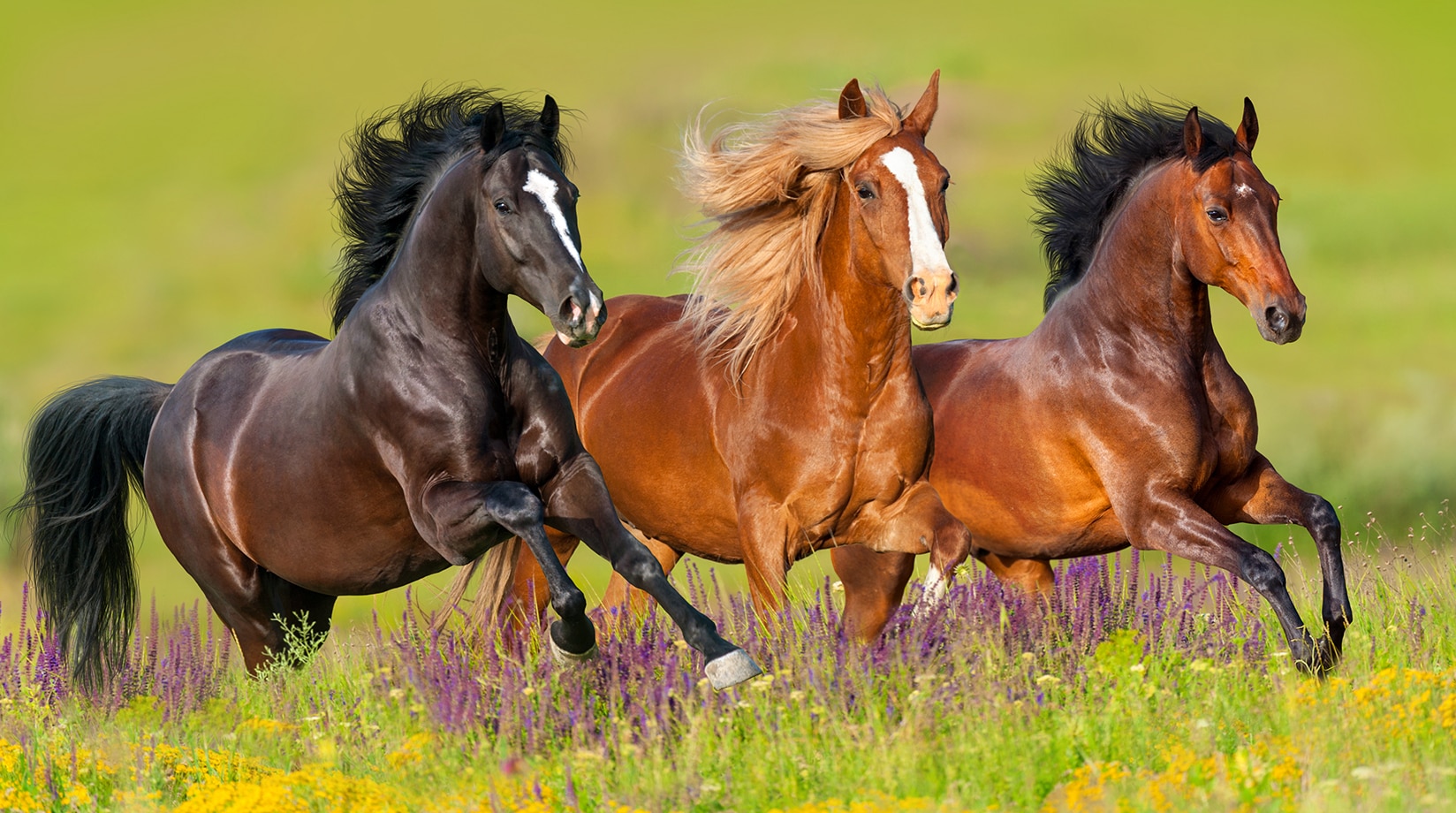
Featured image © Rita Kochmarjova
Fun fact image © Daniel Krueger | Unsplash
1. Brooks, S. A., S. Makvandi-Nejad, E. Chu, J. J. Allen, C. Streeter, E. Gu, B. McCleery, B. A. Murphy, R. Bellone, and N. B. Sutter. 2010. “Morphological Variation in the Horse: Defining Complex Traits of Body Size and Shape.” Animal Genetics 41 (November): 159–65. https://doi.org/10.1111/j.1365-2052.2010.02127.x.
2. “Sport Breeds Ponies Draught Breeds W/O Belgian Conserving Equine Diversity: Time for Action.” 1000. https://livestockconservancy.org/wp-content/uploads/2021/01/ConservingE….
3. NIELSEN, B. D., K. K. TURNER, B. A. VENTURA, A. D. WOODWARD, and C. I. O’CONNOR. 2006. “Racing Speeds of Quarter Horses, Thoroughbreds and Arabians.” Equine Veterinary Journal 38 (S36): 128–32. https://doi.org/10.1111/j.2042-3306.2006.tb05528.x.
4. “The IUCN Red List of Threatened Species.” 2019. IUCN Red List of Threatened Species. Name. 2019. https://www.iucnredlist.org/species/41763/97204950.
5. “The IUCN Red List of Threatened Species.” 2019. IUCN Red List of Threatened Species. Name. 2019. https://www.iucnredlist.org/species/41763/97204950.
6. BBC News. 2022. “Twelve Konik Pony Foals Born at Wicken Fen Nature Reserve,” May 27, 2022, sec. Cambridgeshire. https://www.bbc.co.uk/news/uk-england-cambridgeshire-61594439.
7. Librado, Pablo, Naveed Khan, Antoine Fages, Mariya A. Kusliy, Tomasz Suchan, Laure Tonasso-Calvière, Stéphanie Schiavinato, et al. 2021. “The Origins and Spread of Domestic Horses from the Western Eurasian Steppes.” Nature 598 (October): 1–7. https://doi.org/10.1038/s41586-021-04018-9.
8. Librado, Pablo, Naveed Khan, Antoine Fages, Mariya A. Kusliy, Tomasz Suchan, Laure Tonasso-Calvière, Stéphanie Schiavinato, et al. 2021. “The Origins and Spread of Domestic Horses from the Western Eurasian Steppes.” Nature 598 (October): 1–7. https://doi.org/10.1038/s41586-021-04018-9.
The horse is a four-legged herd animal. Various breeds of the animal have been domesticated and are used for work, riding and as a source of food and milk. Historically, the domestication of horses helped humans to spread across the world and also improved their ability to farm.
Foal, filly (female), colt (male)
Herd
Forage (grass and hay)
Mountain lions, wolves, bears and other large carnivores
25-30 years on average
0.43-2.1m (1.4-6.9ft) from hoof to the top of the shoulder
26-1,000kg
60 million (estimated)
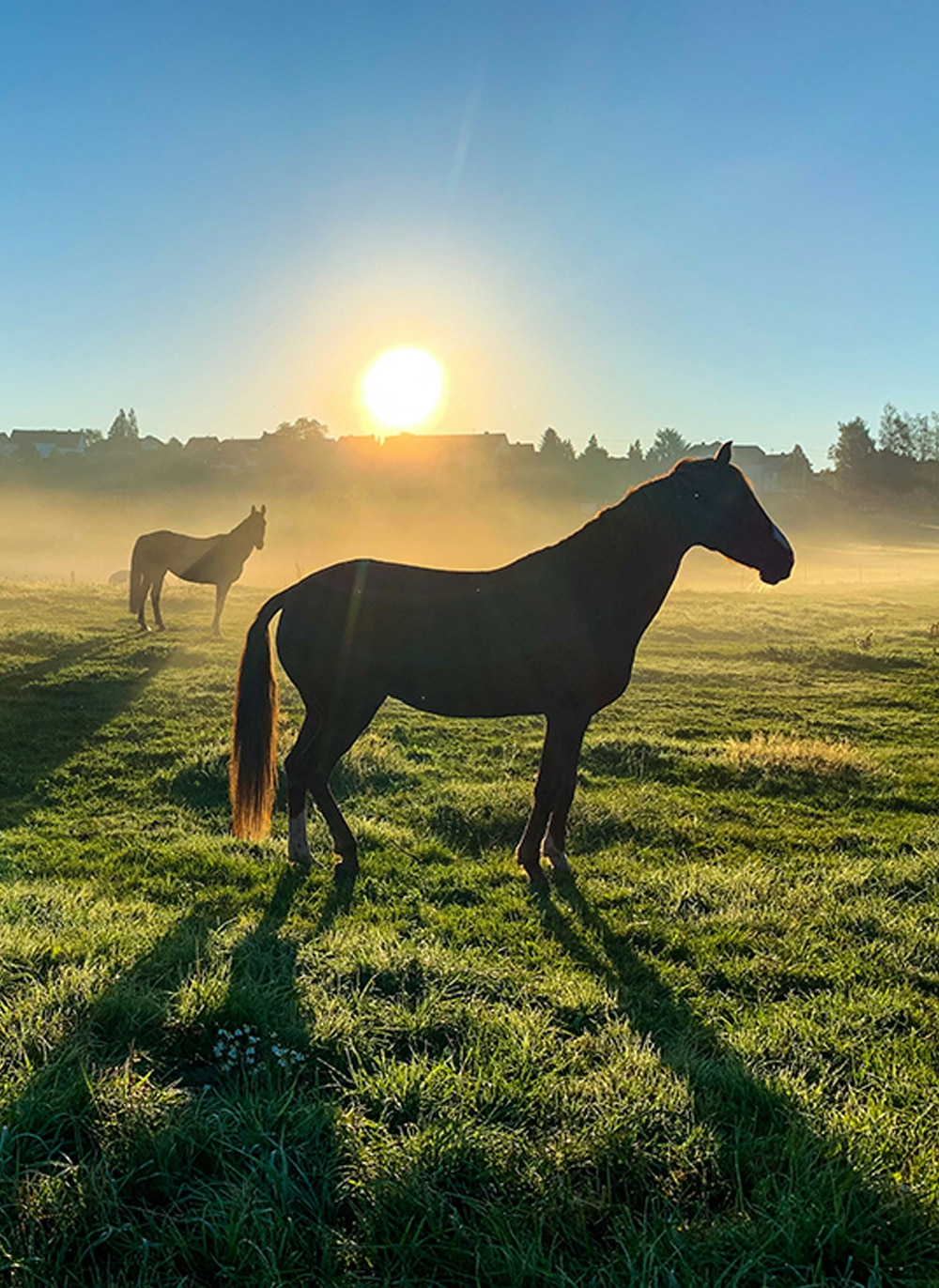
Horses have big hearts, which can weigh several kilogrammes and grow as large as a melon.
Domesticated horses (Equus ferus caballus) come in a host of different shapes, colours and sizes. From tiny Shetland ponies, who stand as high as your waist, to giant Shire horses that tower over us, humans have bred horses over the centuries to fulfil a variety of purposes.
Horses have a long mane that runs down their neck in a thin stripe, and a long flowing tail. Their coats are typically white, grey, brown, black, or a combination of these.
As a prey animal for mountain lions, wolves and bears, horses have evolved to possess excellent hearing and near-360 degree vision. This is typical for a species which must watch out for predators. But horses have less impressive grey matter. The average horse’s brain typically weighs around 600g – about half that of a human’s brain.
Being as fast and as strong as a horse requires some hefty organs. Horses have big hearts, which can weigh several kilogrammes and grow as large as a melon. Hearts this large help horses to pump more blood around their bodies so that they can deliver oxygen to their large, powerful muscles, which are needed for sprinting long distances. Horses are incredibly lean animals – half of their body weight is made up of muscle.
Horses can live into their 40s, though the average lifespan is typically around 25-30 years.

The largest breed of horse is the Shire, closely followed by the Clydesdale, Belgian Draft, Percheron and Suffolk Punch.1 These breeds can weigh over 900kg and typically measure 160-210cm (5.2-6.9ft) from the ground to the top of their shoulders, known as a horse’s "withers”. Traditionally, domesticated horses have been measured in "hands", with one hand measuring slightly over 10cm. They are still measured this way by horse breeders.
All five breeds belong to a group of horses called draft horses. These breeds are known for their incredible strength and stamina and were used to pull ploughs and other farm machinery before the advent of motorised tractors. They were also used in wars to move large artillery.
You might have heard of the term "horsepower". This term originated in the 18th Century as a way to measure the power output of steam engines by comparing it to working horses. Interestingly, while the term implies the power of a single horse, the strongest horses can actually produce a peak power output that exceeds 15 horsepower! Today, this term is still widely used to denote a car's power.
These breeds are rarely used for farming today and are bred for show instead. The Suffolk Punch is one of the rarest breeds of horse and numbers fewer than 1,000 individuals worldwide.2
The smallest horse breeds are miniature horses, including Falabellas, Shetlands, Nomas and Yonagunis. These breeds are exclusively bred for show and for keeping as pets.
The Quarter horse and Thoroughbred are two of the fastest breeds of horse. The former can reach top speeds in excess of 50mph (80kmph).3

Young horses are called a foal for their first year after birth. Then from one year until adulthood they are either a filly if they are female or colt if they are male. Historically, in the wild, herds of horses would have consisted of separate groups of males and females. The males would track the female groups and attempt to win the right to mate with the group of females exclusively. Males might fight with each other by kicking with their forelegs and biting each other.
During mating, the successful male, called a stallion, might bite the neck of the female to assert dominance, while unsuccessful males return to their group of bachelors.
Horses have long pregnancies – generally around 11 months, which is longer than human pregnancies. Newborn horses, called foals, can walk and run within hours of being born, which was essential to their survival in the wild as they kept up with the rest of their herd.
Until the early 20th century, wild horses lived in huge, open areas of grassland in Central Asia called the Eurasian steppe. This habitat stretches from Eastern Europe to the east of China south of Siberia and north of the Gobi desert. The Eurasian Steppe is temperate and semi-arid, meaning it is quite dry, not too hot or cold and offers a climate which horses find comfortable to live in.

The only close living relative of the domesticated horse is a species called Przewalski's horse (Equus ferus przewalskii), the last remaining species of wild horse. Przewalski's horses, named after the Russian-Polish explorer Nikolay Przhevalsky, are not ancestors of today’s domesticated horses, they are in fact distant cousins who have been reintroduced into the wild in some areas of Mongolia.4
Przewalski's horses once lived across the steppes of Russia, Mongolia, China and Kazakhstan, but were hunted to extinction in the wild in the 20th century.
Historically, wild horses were revered by humans, due to both their rarity and the difficulty in catching them. This is mentioned in ancient texts written by the Tibetan monk Bodowa in 900 AD and in accounts of the Mongol ruler Genghis Khan’s travels in the 1200s.
Western animal collectors and zoos attempted to catch these wild horses for their collections. But because Przewalski's horses are shy and very fast, the collectors and zoos had to resort to killing the adults and capturing the foals. Many foals died in captivity or in transit to the zoos. Others were killed by trophy hunters.
The last wild Przewalski's horse was seen in Mongolia in 1969. But they were reintroduced to protected areas in Mongolia after being bred from captive populations in 1994. These herds are considered fully wild and live without any assistance from humans. There are now some populations in Chinese nature reserves, such as Kalamaili Nature Reserve and the Dunhuang Xihu National Nature Reserve, which are human-fed in the winter. In total, there are approximately 387 reintroduced Przewalski's horses in Mongolia and they are considered endangered on the IUCN Red List.5
All of the Przewalski's horses alive today, both captive and reintroduced, are descended from 12 wild-caught horses which were bred with domesticated horses. This has led to concerns about the potential for inbreeding and the outlook for the species in the long term. To address this, there is international cooperation between different captive breeding programmes so that genetic diversity can be maintained, and wild populations are closely monitored for disease.
It is thought that humans once lived alongside Przewalski's horses in Europe. The horses appear to feature in cave paintings dating as far back as 20,000 years ago in Spain, Italy and France – although these paintings might depict an extinct horse species called Equus ferus gmelini, but some zoologists question whether this is a separate species in its own right.
While very similar to domesticated horses, Przewalski's horses are slightly different — for instance, their manes stand up on the back of their neck like a bristly brush. This looks a little like a donkey’s mane, rather than a horse’s flowing locks. Przewalski's horses have little by way of forelocks — the fringe on the front of the mane which falls between the ears and over the face of a domesticated horse — which again presents a greater similarity with asses and donkeys than with domesticated horses.
Other "wild" horses are actually feral domesticated horses. For example, a Polish domesticated horse breed called the Konik has become feral in some areas of Europe, and has even been introduced intentionally to some nature reserves to control plant species.6 The Konik ponies in Wicken Fen in Cambridgeshire and Redgrave Fen in Suffolk, UK, help to manage wetlands by preventing some larger species of plants from dominating the landscape.
Domestic horses become feral when they either escape or are released into a wild landscape and lose their tameness. These horses might become more dangerous to humans who approach them.
Aside from Przewalski's horses, the Equus genus also features the plains zebra, Grevy’s zebra, Kiang (an ass-like animal) and wild asses, from which domesticated asses and donkeys were originally bred.

It is believed that humans first domesticated horses in around 3500 BC in Central Asia. This is largely due to the discovery of archaeological evidence including bridles – the straps held around the head of horses from which a rein is attached – and corrals, or temporary enclosures, from this time at a settlement called Botai in modern-day Kazakhstan.7
To what degree these horses were domesticated is contentious. Some archaologists exploring sites in Asia have suggested that they were kept in fenced corrals to provide a source of easily-available food and milk, but were largely left to their own devices. Some modern human societies, like the Sami people from the north of Finland and Norway, keep reindeer in a similar fashion. Whether they were intentionally bred and trained for riding is much harder to prove.
However, it is possible that humans have been riding horses since around 3000 BC, which would coincide with the massive increase in the spread of nomadic Central Asian cultures like the Yamnaya and the invention of heavy, solid-wheeled wagons around that time.
However, genetic evidence suggests that modern horses – Equus ferus caballus – are descended from another population of animals from around 2000 BC, which replaced the first domesticated horses.8

Featured image © Rita Kochmarjova
Fun fact image © Daniel Krueger | Unsplash
1. Brooks, S. A., S. Makvandi-Nejad, E. Chu, J. J. Allen, C. Streeter, E. Gu, B. McCleery, B. A. Murphy, R. Bellone, and N. B. Sutter. 2010. “Morphological Variation in the Horse: Defining Complex Traits of Body Size and Shape.” Animal Genetics 41 (November): 159–65. https://doi.org/10.1111/j.1365-2052.2010.02127.x.
2. “Sport Breeds Ponies Draught Breeds W/O Belgian Conserving Equine Diversity: Time for Action.” 1000. https://livestockconservancy.org/wp-content/uploads/2021/01/ConservingE….
3. NIELSEN, B. D., K. K. TURNER, B. A. VENTURA, A. D. WOODWARD, and C. I. O’CONNOR. 2006. “Racing Speeds of Quarter Horses, Thoroughbreds and Arabians.” Equine Veterinary Journal 38 (S36): 128–32. https://doi.org/10.1111/j.2042-3306.2006.tb05528.x.
4. “The IUCN Red List of Threatened Species.” 2019. IUCN Red List of Threatened Species. Name. 2019. https://www.iucnredlist.org/species/41763/97204950.
5. “The IUCN Red List of Threatened Species.” 2019. IUCN Red List of Threatened Species. Name. 2019. https://www.iucnredlist.org/species/41763/97204950.
6. BBC News. 2022. “Twelve Konik Pony Foals Born at Wicken Fen Nature Reserve,” May 27, 2022, sec. Cambridgeshire. https://www.bbc.co.uk/news/uk-england-cambridgeshire-61594439.
7. Librado, Pablo, Naveed Khan, Antoine Fages, Mariya A. Kusliy, Tomasz Suchan, Laure Tonasso-Calvière, Stéphanie Schiavinato, et al. 2021. “The Origins and Spread of Domestic Horses from the Western Eurasian Steppes.” Nature 598 (October): 1–7. https://doi.org/10.1038/s41586-021-04018-9.
8. Librado, Pablo, Naveed Khan, Antoine Fages, Mariya A. Kusliy, Tomasz Suchan, Laure Tonasso-Calvière, Stéphanie Schiavinato, et al. 2021. “The Origins and Spread of Domestic Horses from the Western Eurasian Steppes.” Nature 598 (October): 1–7. https://doi.org/10.1038/s41586-021-04018-9.
Foal, filly (female), colt (male)
Herd
Forage (grass and hay)
Mountain lions, wolves, bears and other large carnivores
25-30 years on average
0.43-2.1m (1.4-6.9ft) from hoof to the top of the shoulder
26-1,000kg
60 million (estimated)

Horses have big hearts, which can weigh several kilogrammes and grow as large as a melon.
Sorry there is no content available for your region.